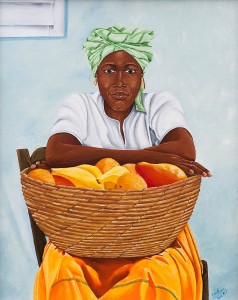
NASHVILLE, Tenn. (TSU News Service) – Freedom was only a dream for Ndume Olatushani, a man who spent 28 years behind bars in maximum-security prisons. Wrongly convicted of murder, he spent 20 of those years on death row.
To escape the tedium and depression of life behind bars Olatushani began painting, by turning to canvas to “live outside of prison” as a way of freeing his mind and spirit.
The paintings, on display at the Tennessee State University’s Avon Williams Campus Library Feb. 28 through April 11, demonstrate the products of his incarceration and the will to change his life after hitting rock bottom.
“I was truly a broken man and the lowest I’ve ever been,” said Olatushani, recounting how he began painting following his mother’s death two years into his prison sentence. His mother Moosie, who never wavered in her belief of her son’s innocence, was killed in a car accident that also claimed the life of his 8-year-old niece.
“After my mom’s death, I decided I couldn’t be hurt anymore,” he added. “I started drawing and eventually taught myself to paint. Through my artwork I lived outside of prison and didn’t paint my surroundings, but instead the people from outside the prison walls I would like to meet.”
Born Erskine Johnson in St. Louis, Olatushani’s troubles began Oct. 26, 1983 while celebrating his mother’s birthday with about 30 relatives. While the family was celebrating, nearly 300 miles away in Memphis, a grocer named Joe Belenchi was murdered while working in the supermarket he owned.

Within several months following the murder, Johnson, who legally changed his name to Ndume (Swahili for masculinity) Olatushani (unifier), was tracked down, charged, convicted and sentenced for the crime—even though he never before set foot in the state of Tennessee. In 1985, at the age of 27, he was sentenced to death.
For nearly three decades, Olatushani spent his time moving from different levels of incarceration, including from Level C – where he spent 23 hours-a-day in forced solitude, with hands and feet shackled during the remaining hour – to Level A, which allowed up to three hours a week for visitations, outdoor time with other convicts in a 12-by-12 cage, and the opportunity to have odd jobs.
In 1991 he started corresponding with a young college student, Anne-Marie Moyes, who had dedicated herself to social justice issues. She began working with Death Penalty Focus, a California-based nonprofit similar to Tennesseans for Alternatives for the Death Penalty. The two met after months of corresponding, and she was so convinced of his innocence, Moyes enrolled in Vanderbilt Law School where she was awarded the law school’s Founder’s Medal – the highest honor bestowed on a single graduate out of every graduating class. The two would spend nearly two decades filing appeals.

In the meantime, a large international firm in New York decided for the first time to take on a death penalty case and filed appeal after appeal on his behalf. Finally in Dec. 2011, the Tennessee Court of Criminal Appeals overturned Olatushani’s murder conviction due to faulty witness testimony and demanded a new trial. On June 6, 2012, Olatushani walked out of prison after accepting an Alford Plea to avoid potentially serving several more years in the Shelby County Jail awaiting a new trial and taking his chances with another jury. This deal required that he plead guilty to second-degree murder, while, at the same time, allowed him to maintain his innocence. In exchange, he was sentenced to time served and was released.
Today, at age 54, Olatushani is a free man living in Nashville with his now wife, Anne-Marie, and their adopted child. Now just two years shy of being released and starting a new life, he is still painting, growing a small vegetable garden and learning about all the advances that did not exist when he was first incarcerated.
“The only real struggle is trying to get used to all these technological advances that have been made,” he said, listing on his fingers all the inventions that didn’t exist when he went to jail in 1983: computers, cell phones, the Internet.
Olatushani’s art exhibit will be on display at the Avon Williams Campus Library Feb. 28 through April 11 and is free and open to the public. The library is open Monday through Thursday from 9 a.m. to 10 p.m., Friday and Saturday from 9 a.m. to 5:30 p.m., and Sunday noon until 8:30 p.m.
For more information call 615.963.7188.
Department of Media Relations
Tennessee State University
3500 John Merritt Boulevard
Nashville, Tennessee 37209
615.963.5331
About Tennessee State University
With nearly 9,000 students, Tennessee State University is Nashville’s only public university, and is a comprehensive, urban, co-educational, land-grant university offering 38 undergraduate, 22 graduate and seven doctoral programs. TSU has earned a top 20 ranking for Historically Black Colleges and Universities according to U.S. News and World Report, and rated as one of the top universities in the country by Washington Monthly for social mobility, research and community service. Founded in 1912, Tennessee State University celebrated 100 years in Nashville during 2012. Visit the University online at tnstate.edu.
